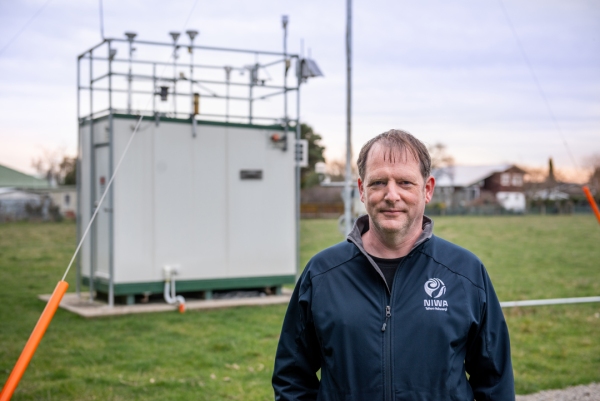This lesson explores how air quality is measured all around Aotearoa New Zealand and where you can access that data.
On this page:
- Introduction
- Key summary points
- Activity: Dust trap
- Find out more: Extra resources
- Quiz: Measuring particles in the air
- Worksheet: Measuring particles in the air
Introduction
All around the country, regional governments take measurements at air quality monitoring stations.
Towns and cities around the country usually have at least one monitoring station.
Air gets drawn through filters in the top to get rid of any large dust particles. The air then gets sucked through a very fine filter paper, where the smaller particles are trapped. The more particles that get trapped, the darker the spot appears on the paper. The filter is kept as a long tape, and every 24 hours gets moved along, so a fresh piece of the filter is exposed. This way we can see how polluted the air was on one day compared with another.
This data is available on LAWA, Land Air Water Aotearoa , where you can see what the particulate levels have been in the past.
You can also see if the monitoring site has observed any days that have measured over the National Environmental Standard, the law that says what the maximum amount of pollution should be over 24 hours.
The following video explains more about how scientists measure air quality:
Key summary points
- There are lots of air quality monitoring stations around the country.
- You can see the data on LAWA, Land Air Water Aotearoa.
Activity: Dust trap
Collect dust using a dust trap – a strip of sticky tape on a piece of paper that collects dust from the air – and learn about the science behind it.
Equipment:
- Field book
- 4 pieces of card (A5 size)
- Pens
- Double-sided tape
- Scissors
- Blu-Tack
Setting the trap
- Select 3 or 4 locations where you would like to set a trap (for example: lounge in your house, school car park)
- Pick out one piece of paper for each location and write down the name of the location, date and time on each piece of paper. If you are doing this with other people, also write your name.
- On each piece of labelled paper, stick a long strip of double-sided tape under the label. This is now your dust trap.
How to deploy
Using a small piece of Blu-Tack, stick your paper on a flat wall or window in your chosen location. (Make sure the labels match the location). Leave them out for as long as you think is appropriate (try 2 weeks).
What to record?
Each day use your notebook to record how dusty your traps are in each location. You could create a table to record whether you think each of your traps are not dusty, a bit dusty or very dusty each day. Even better – take a photo!
What is your final assessment?
Using the information you recorded, try and answer the following questions:
- Where did you trap the most and least dust? Can you think of reasons for this difference?
- Do you think you would get different results if you repeated the activity in the same locations for a longer period, shorter period or same period of time? What would happen at different times of the year?
- Can you think of any ways to improve this activity? OR if you were to repeat the activity, what would you do differently?
Create a poster, report or presentation of your results including your photos.
Know the science behind it
How does this work? Our air contains very tiny particles. These tiny particles can blow with the wind and move around but will eventually settle on surfaces like walls, floors and furniture. Double-sided tape acts as a 'glue' for the particles and traps them on the surface. If there are enough particles, you can start to see them.
How do these particles get in the air? Particles are released due to many activities such as moving cars, burning wood or coal, cooking, clothing fibre or even animal hair! Can you think of any others?
How does the weather affect it all? if the winds are strong, they keep mixing and swirling the particles around. Low temperatures and calm winds are perfect conditions for the particles to settle down. If it rains heavily, it washes the particles out of the atmosphere.
Are they harmful? Too much of anything is bad! But some particles are more harmful than others.
Find out more: extra resources
Quiz: Measuring particles in the air
Check out our air quality quiz over on Kahoot.
The quiz works best on Kahoot, but if you prefer a text version, you can download it as a PDF [125 KB].
Worksheet: Measuring particles in the air
Download worksheet [PDF 75 KB]

